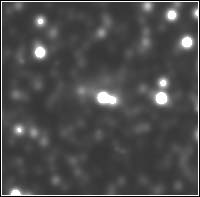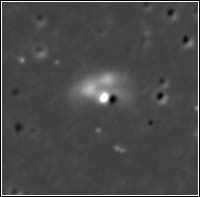

The second image is the exact same picture as the M22 picture above, but a continuum image was subtracted from the [OIII] image above to enhance the visibility of the emission-line nebula. The "dual headlight" white spots just above the center of the picture show the brightest parts of the nebula, but there are also faint wisps tailing away and downward. This nebula is extremely bizarre in that (1) it is only 1 of 4 known in globular clusters, (2) it is only 1 of 4 known to be completely devoid of hydrogen (like Abell 78 above), and (3) it is only 1 of about 3 known to be sweeping through the interstellar medium (like Abell 35 above). The central star is the bright star in the middle of the picture.
Shape:
Distance: approx. 10,000 light years
Location: Sagittarius constellation
RA: 18 36 24.21 DEC: -23 54 12.2
Size: 10" x 7"
Abundances/Description: Visible to the naked eye, the cluster contains more than 70,000 stars along with several other indentified variables.
Discoverer: M22: Abraham Ihle (1665), GJJC-1: IRAS (1989)
Other Links:
Author: George Jacoby
Planetary Nebula Sampler